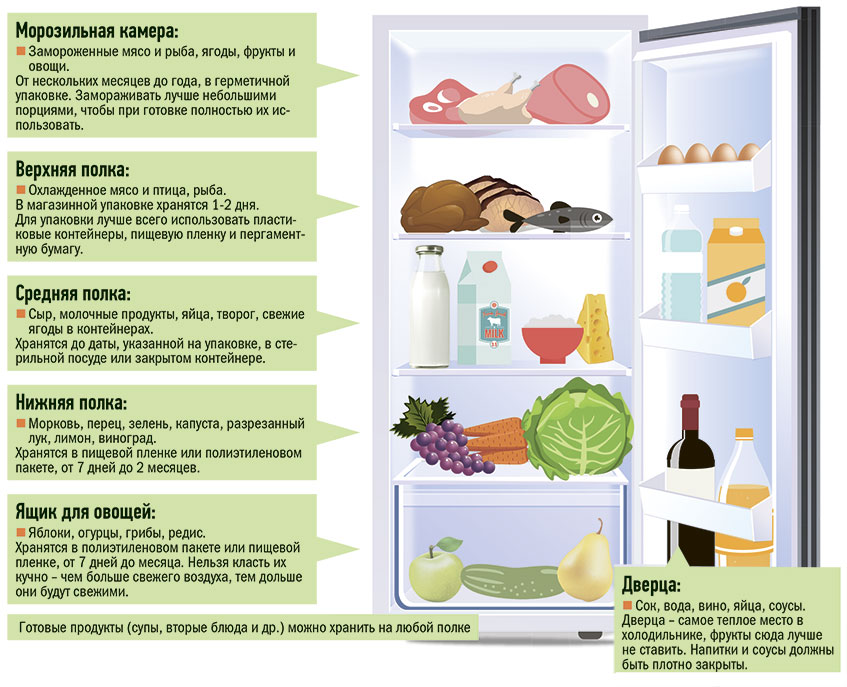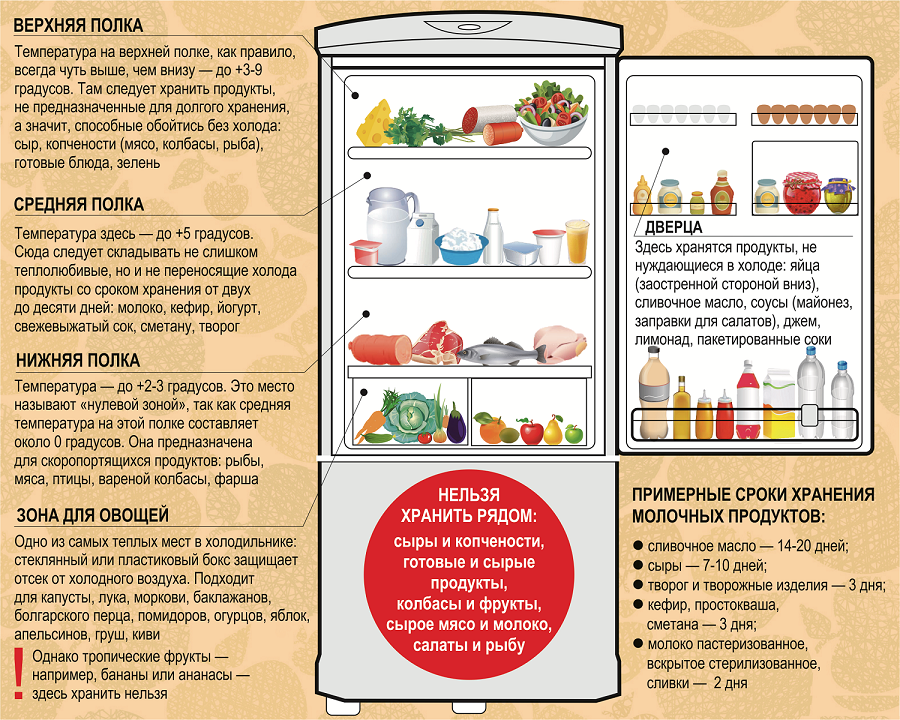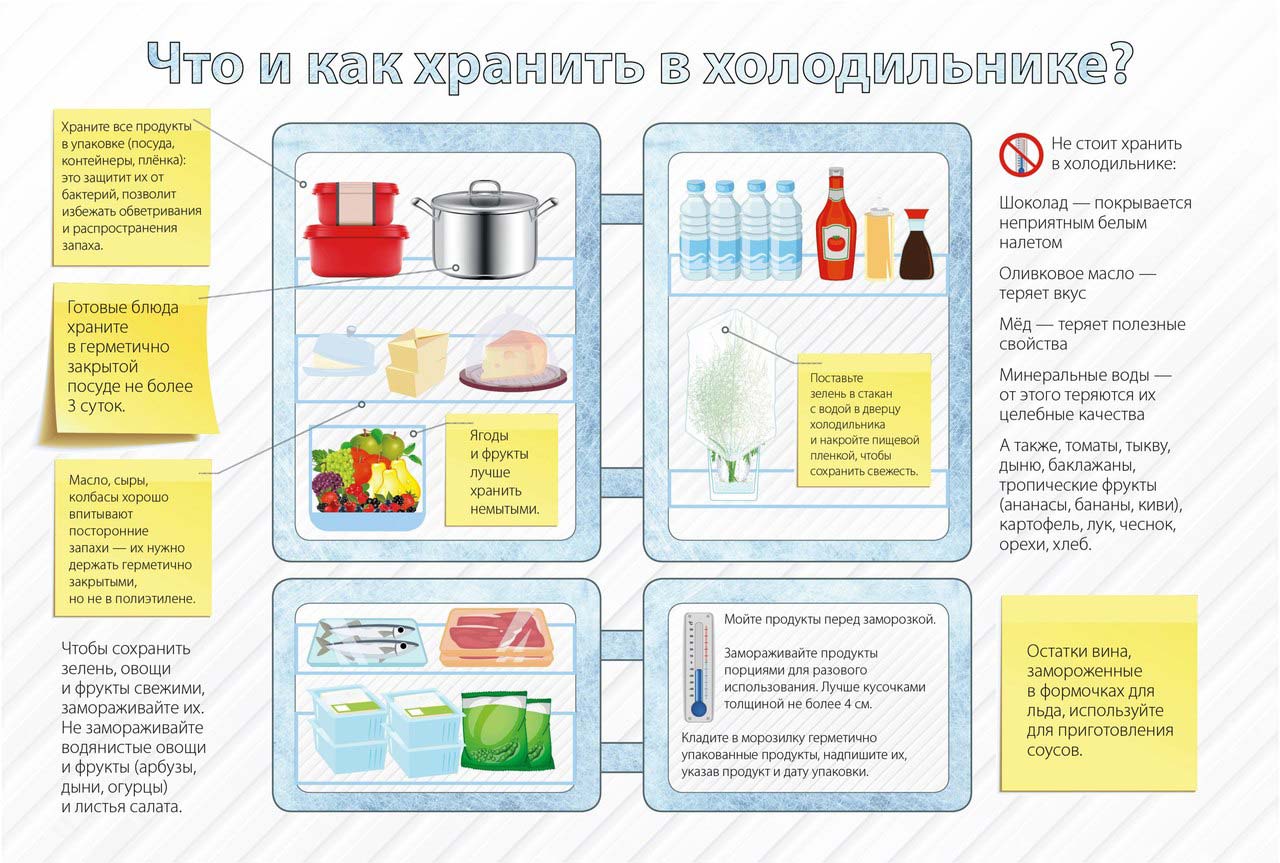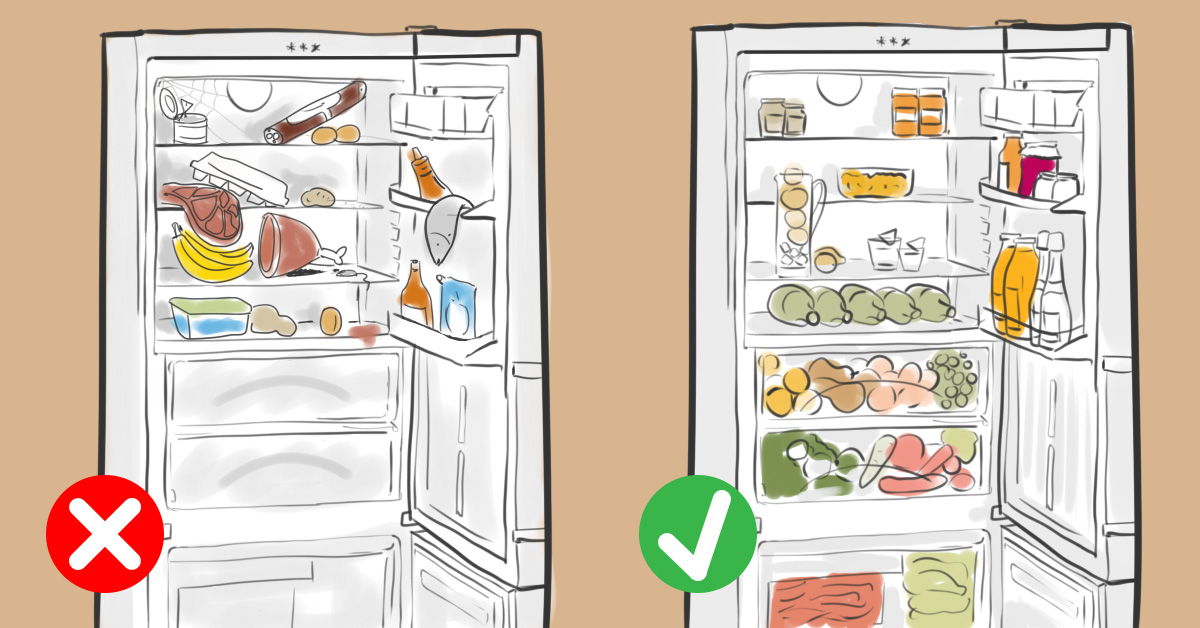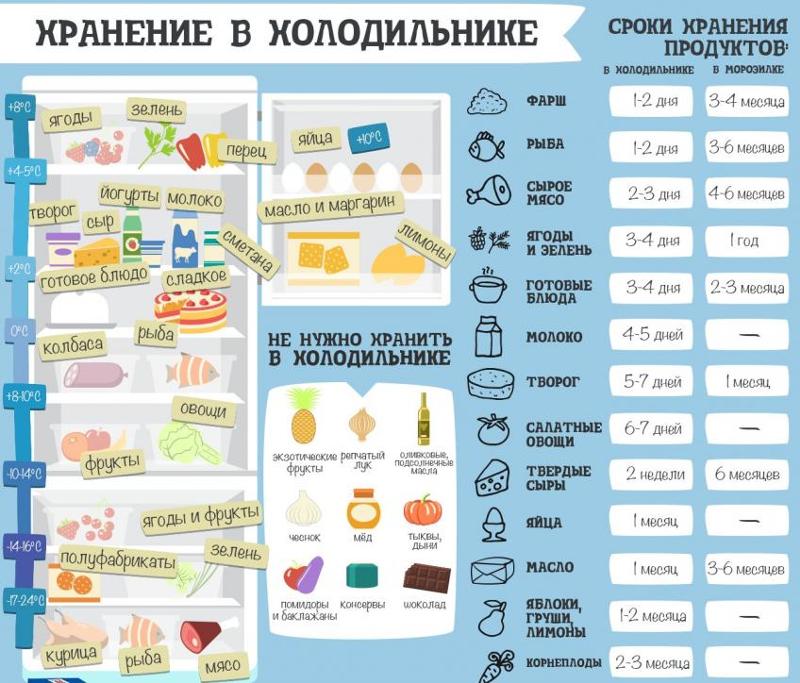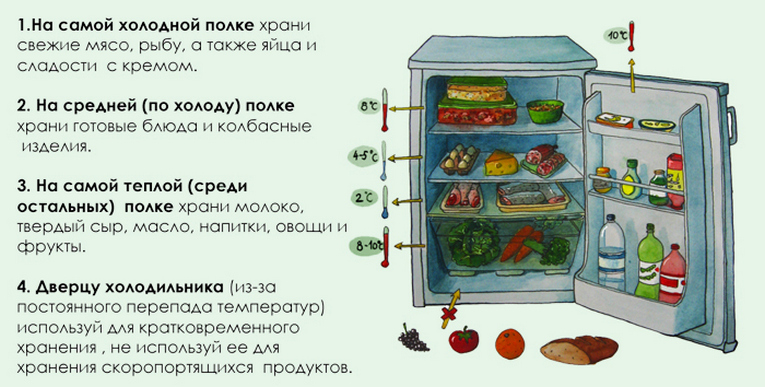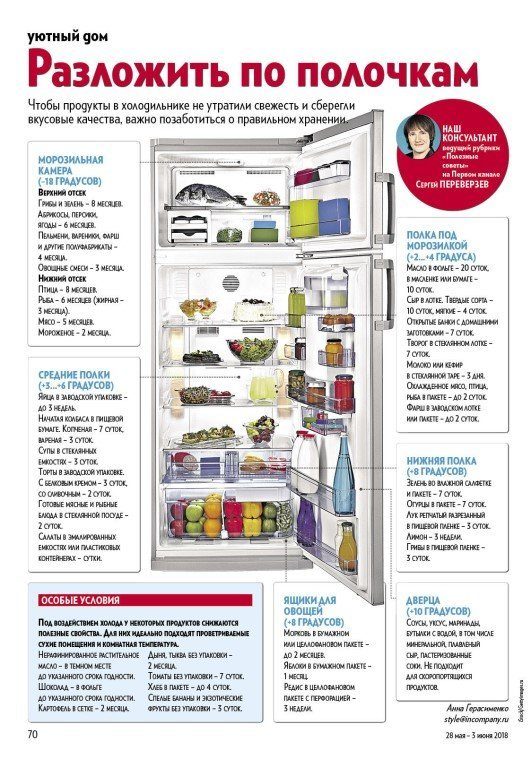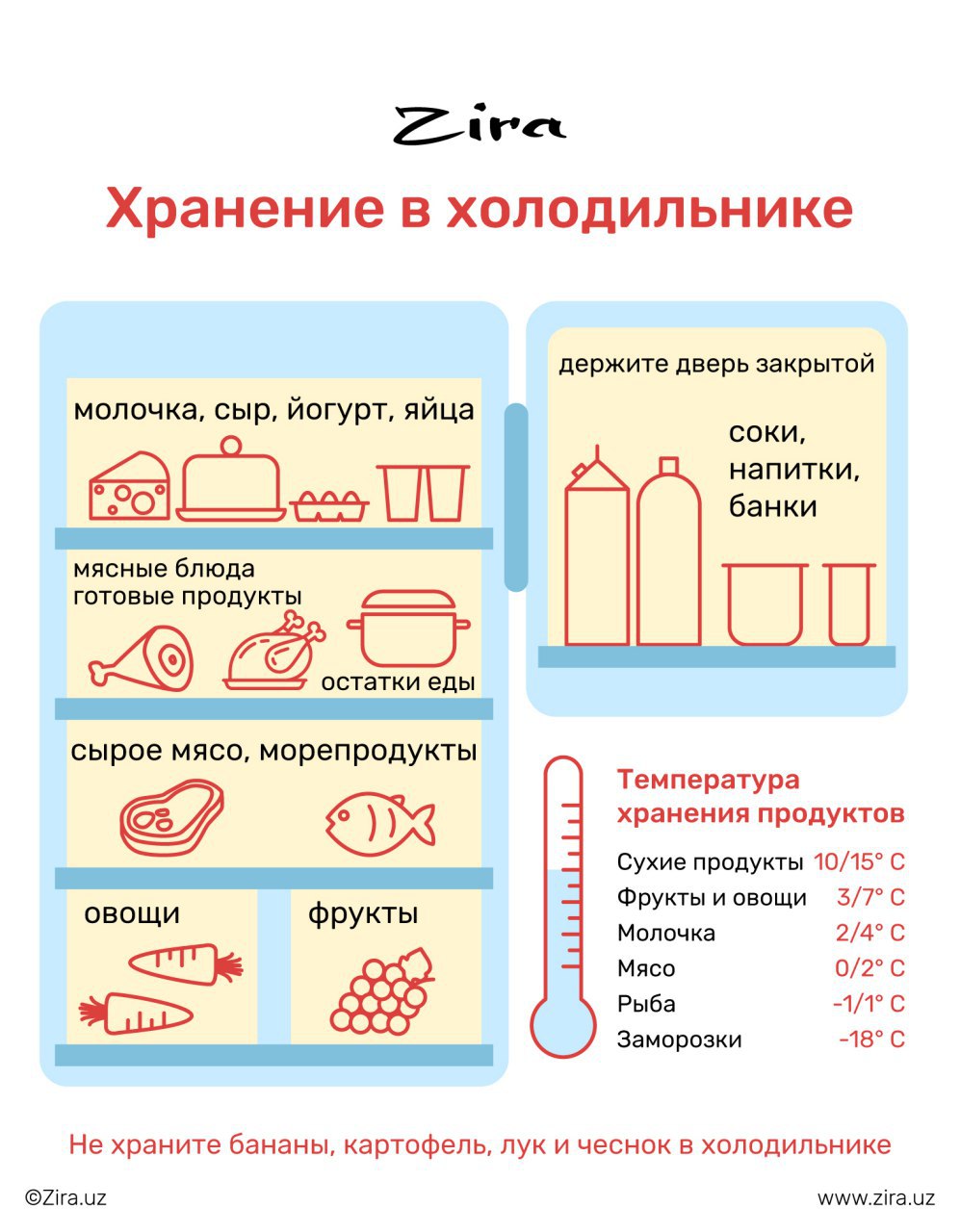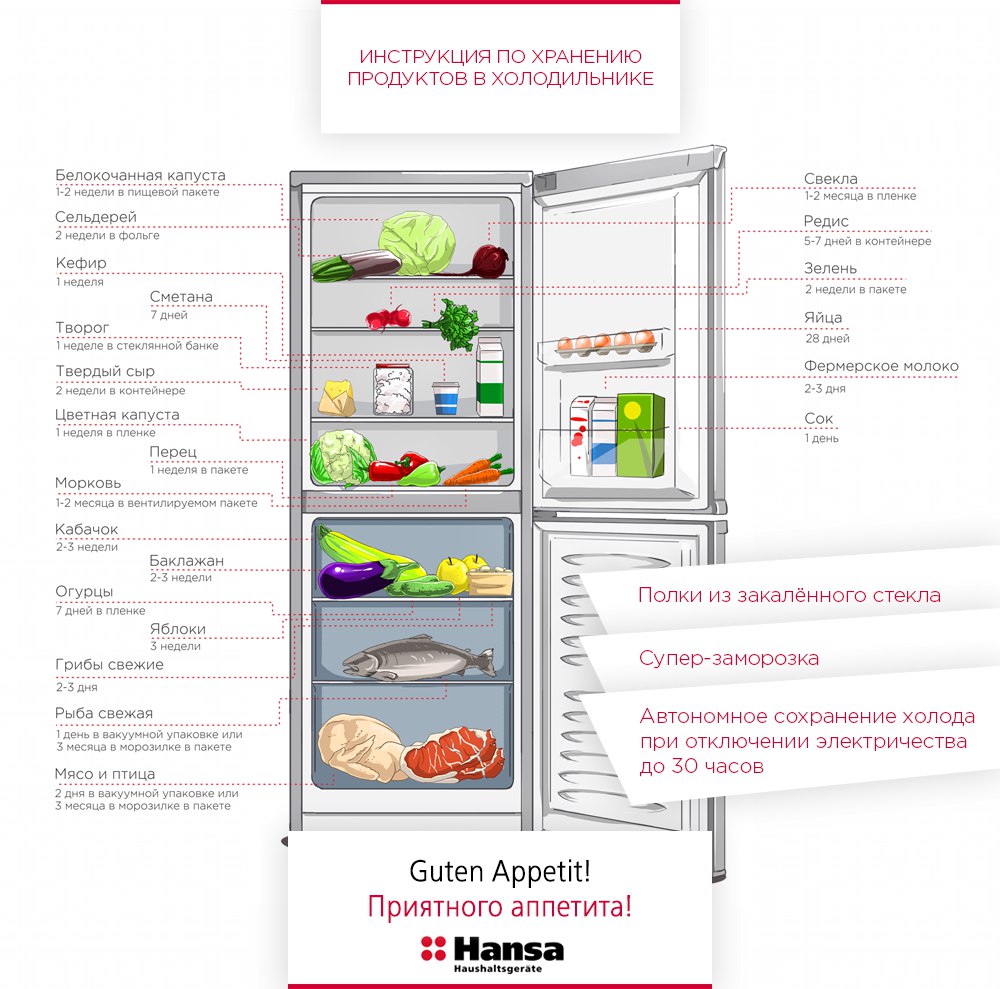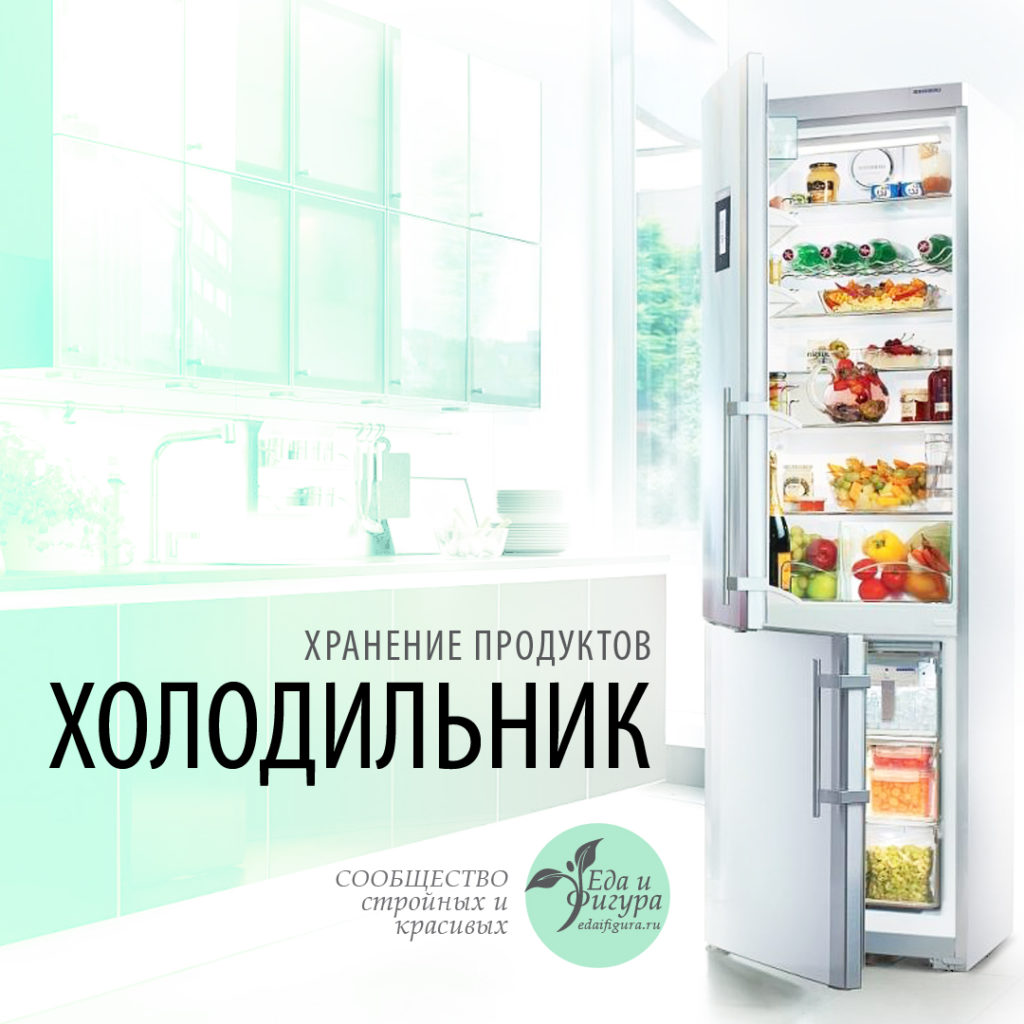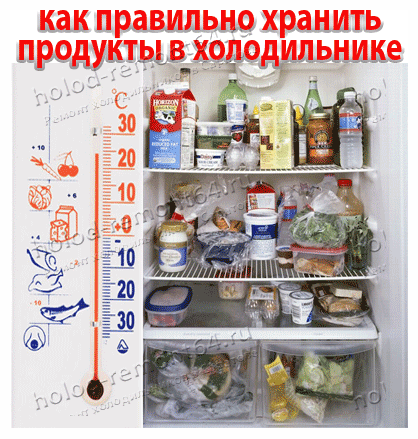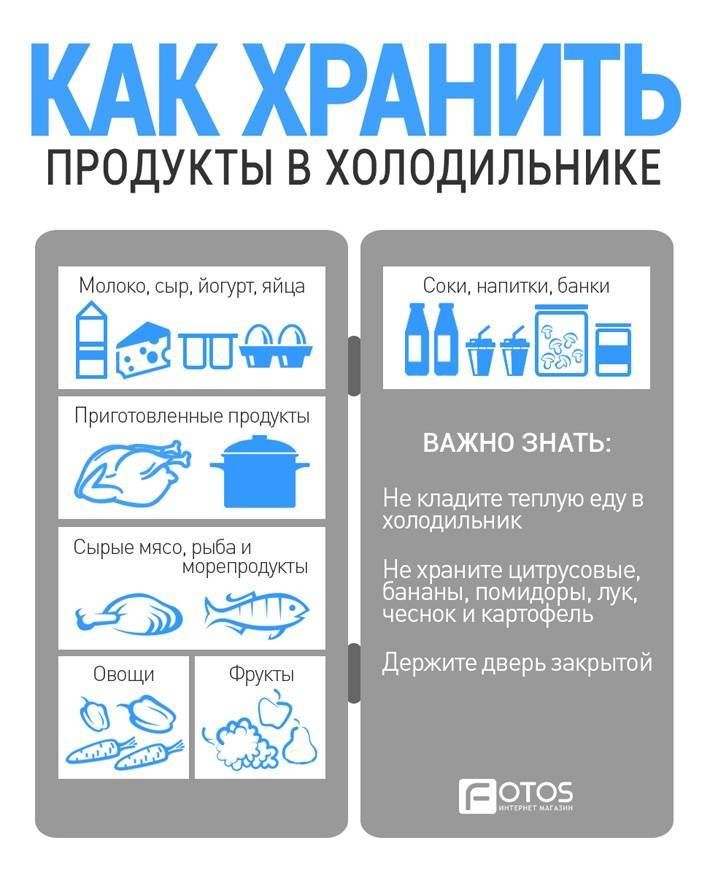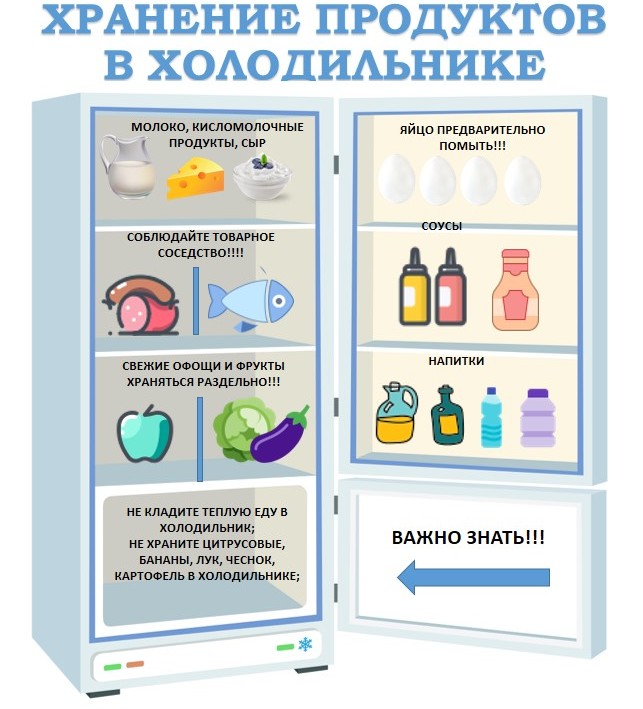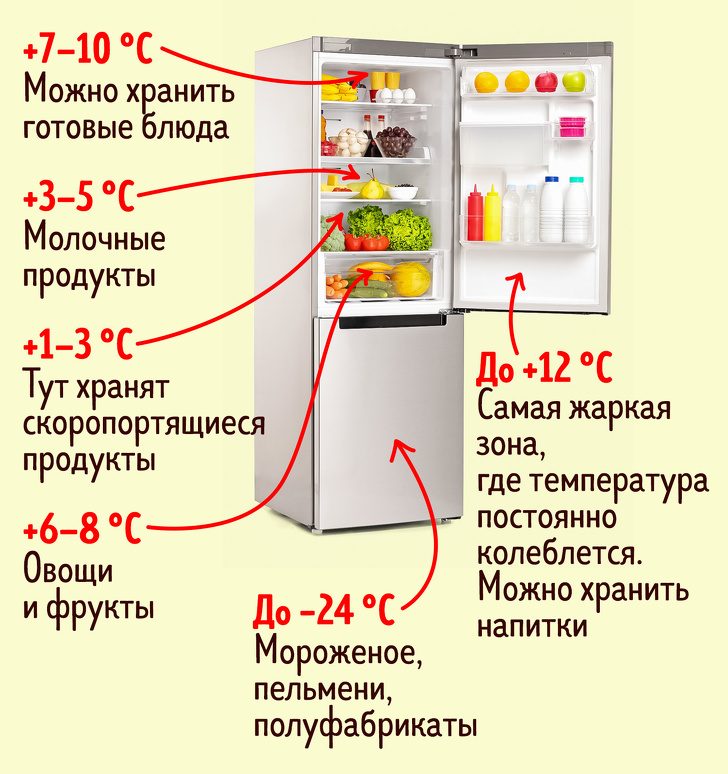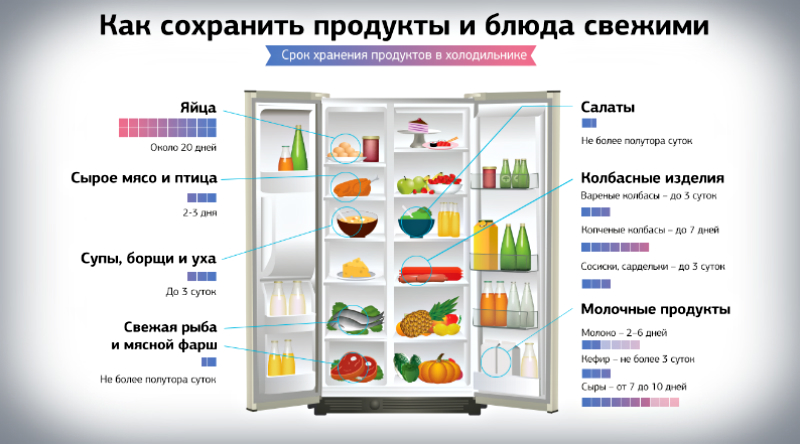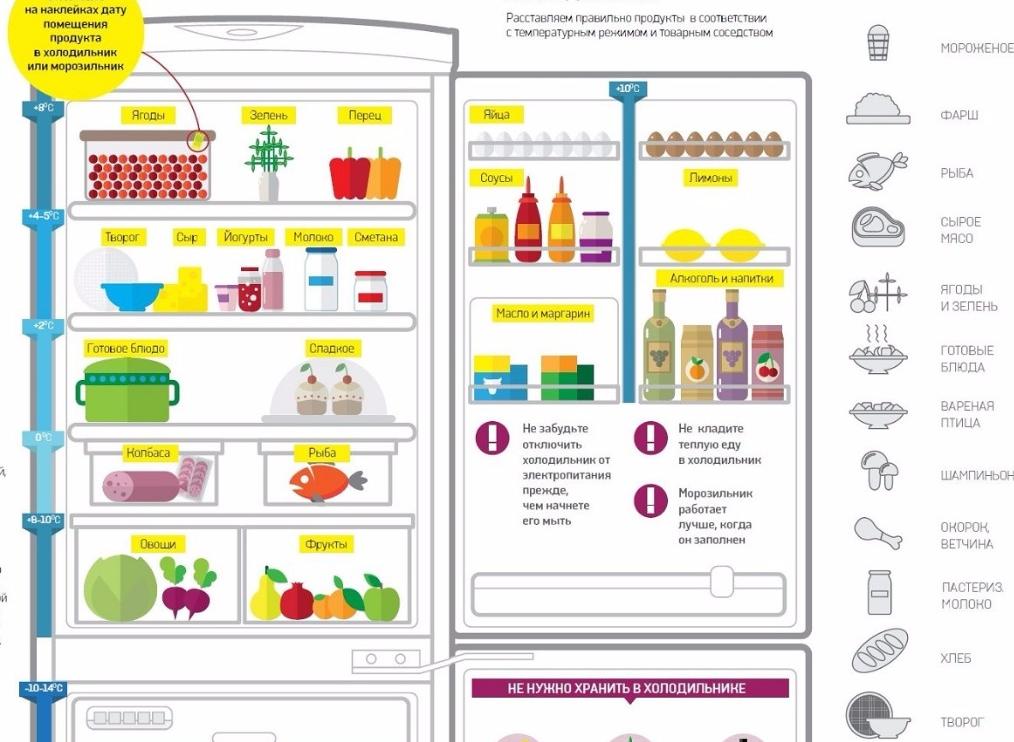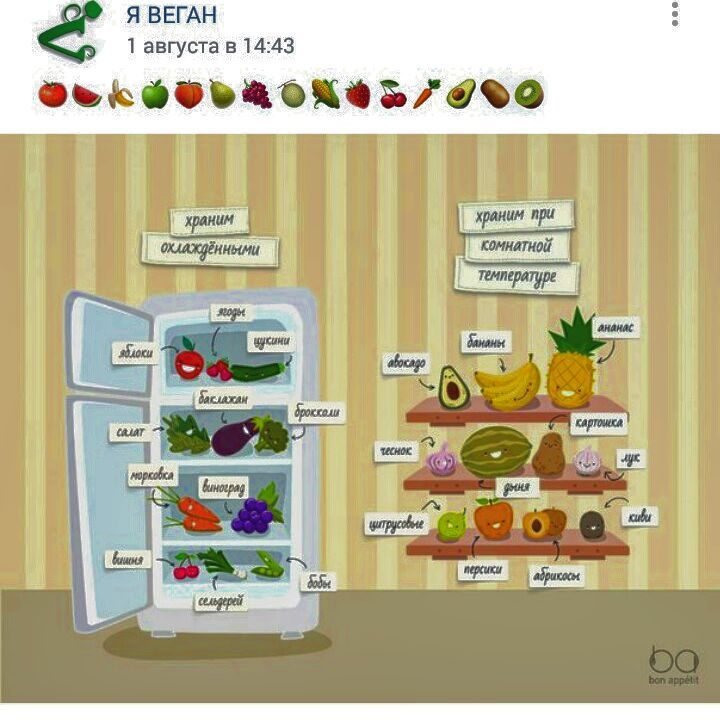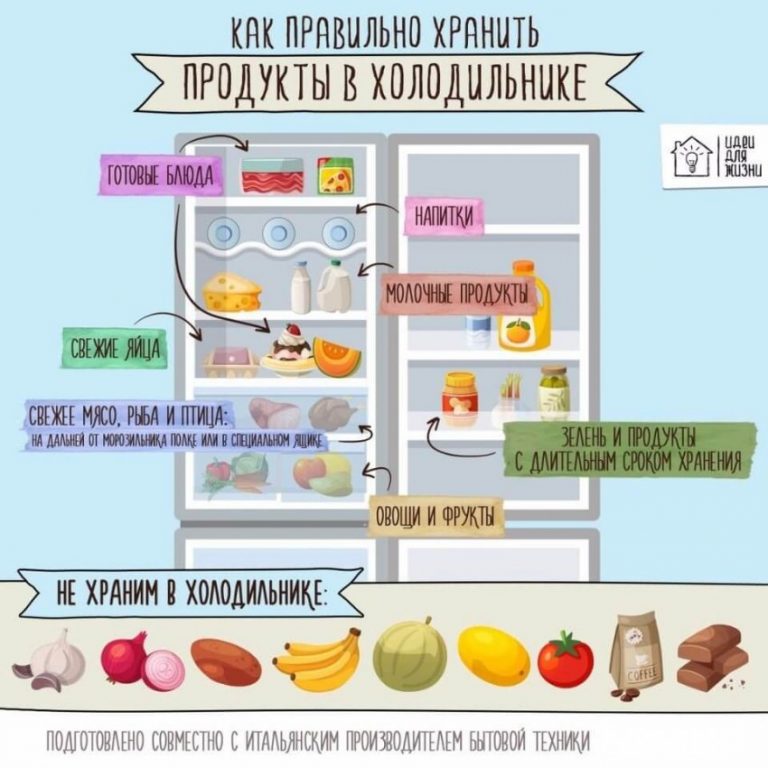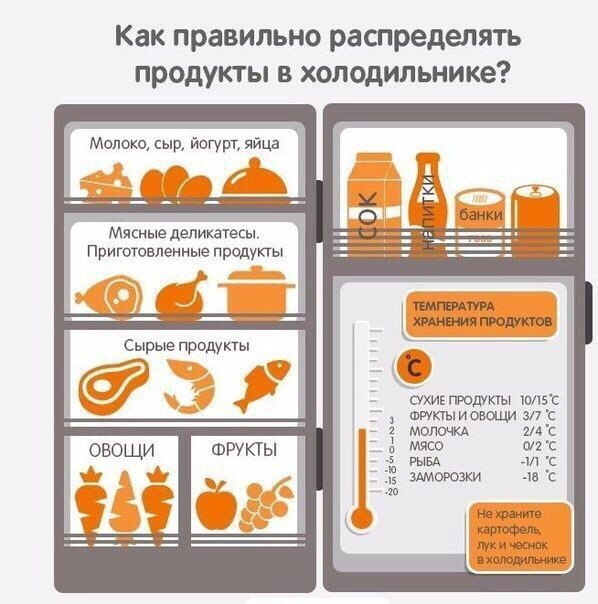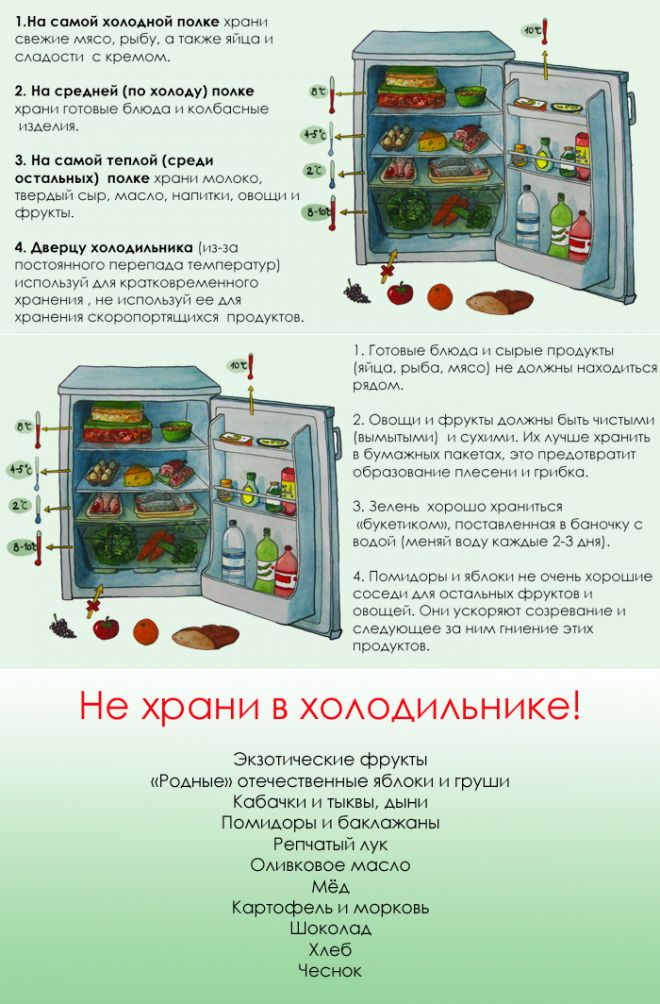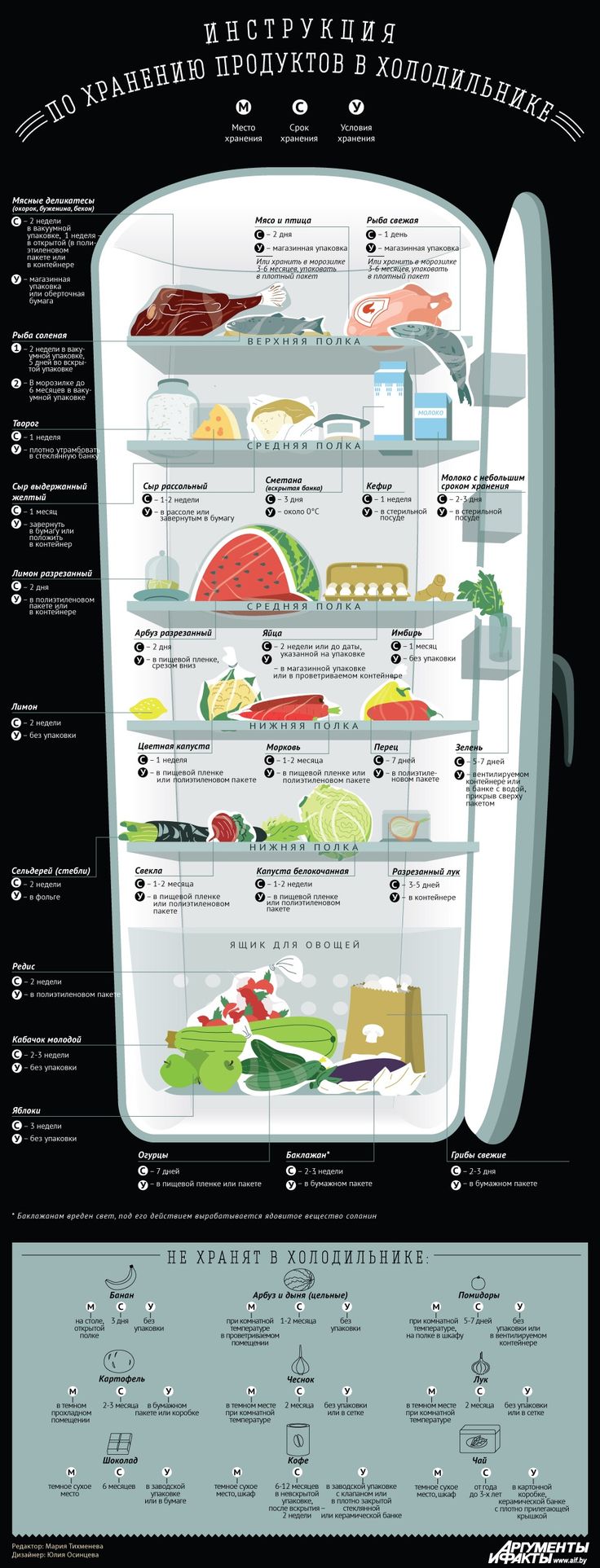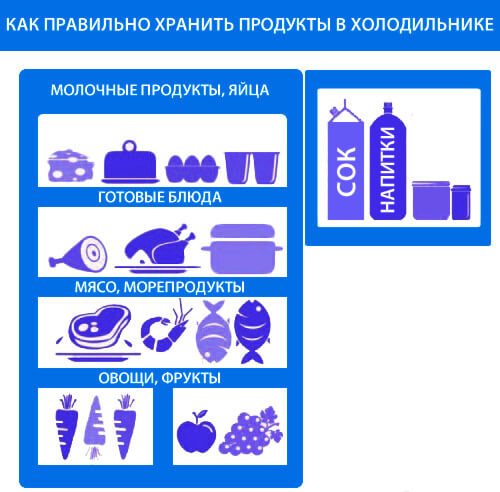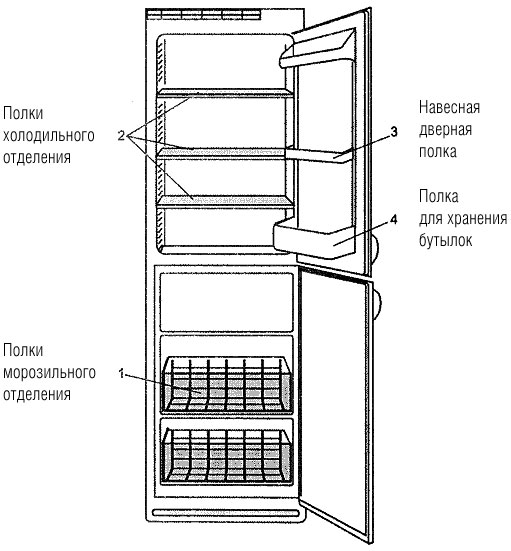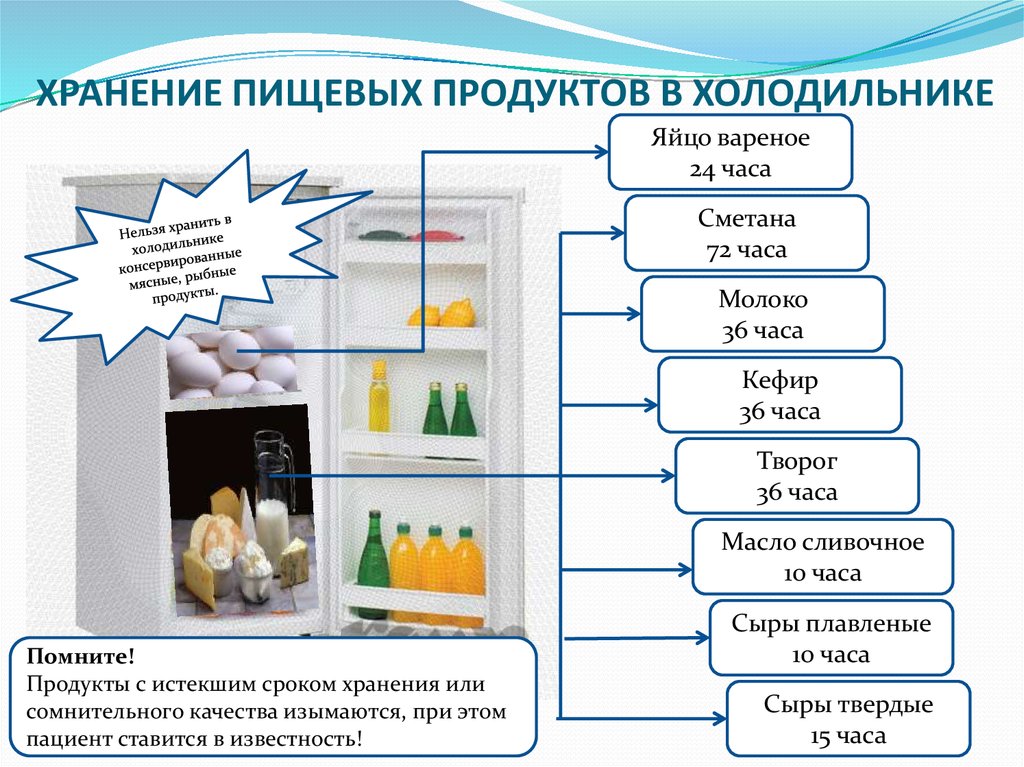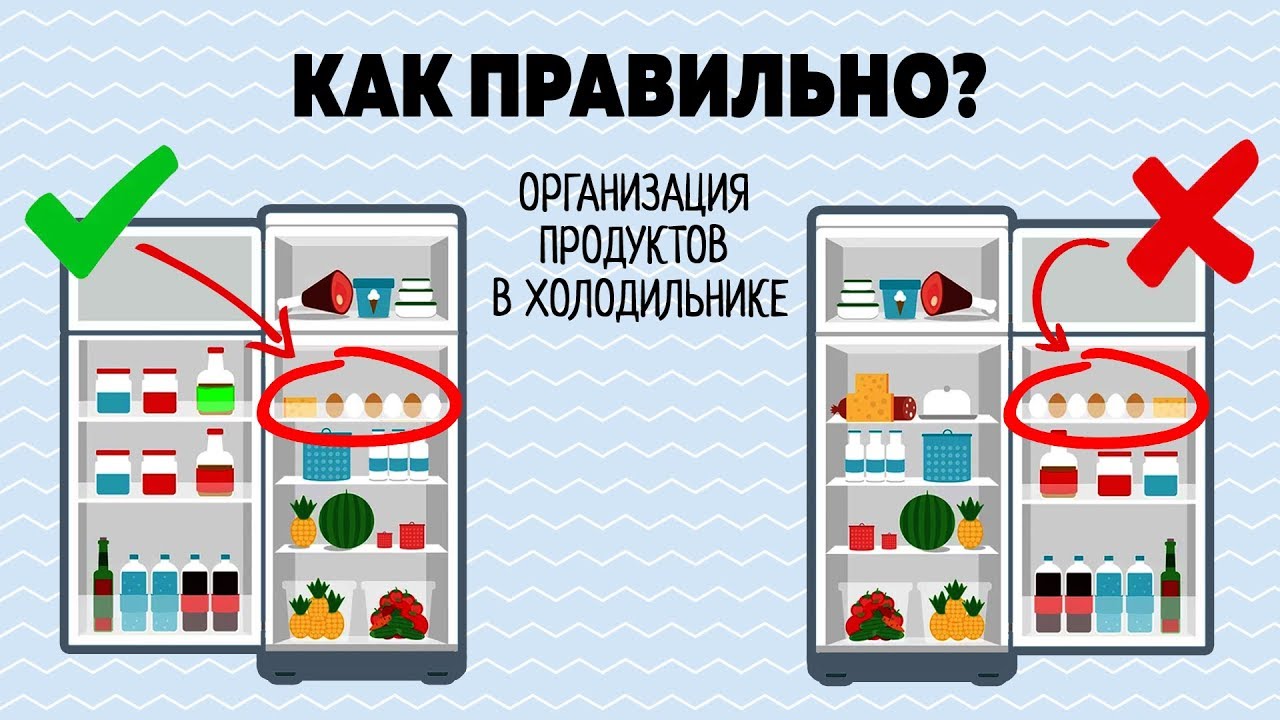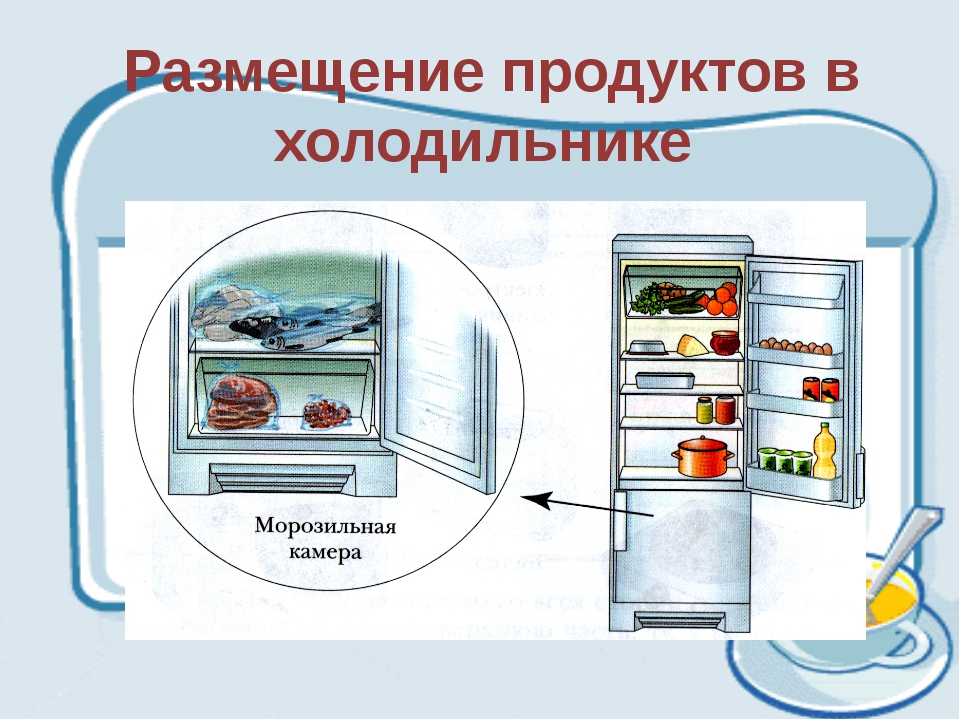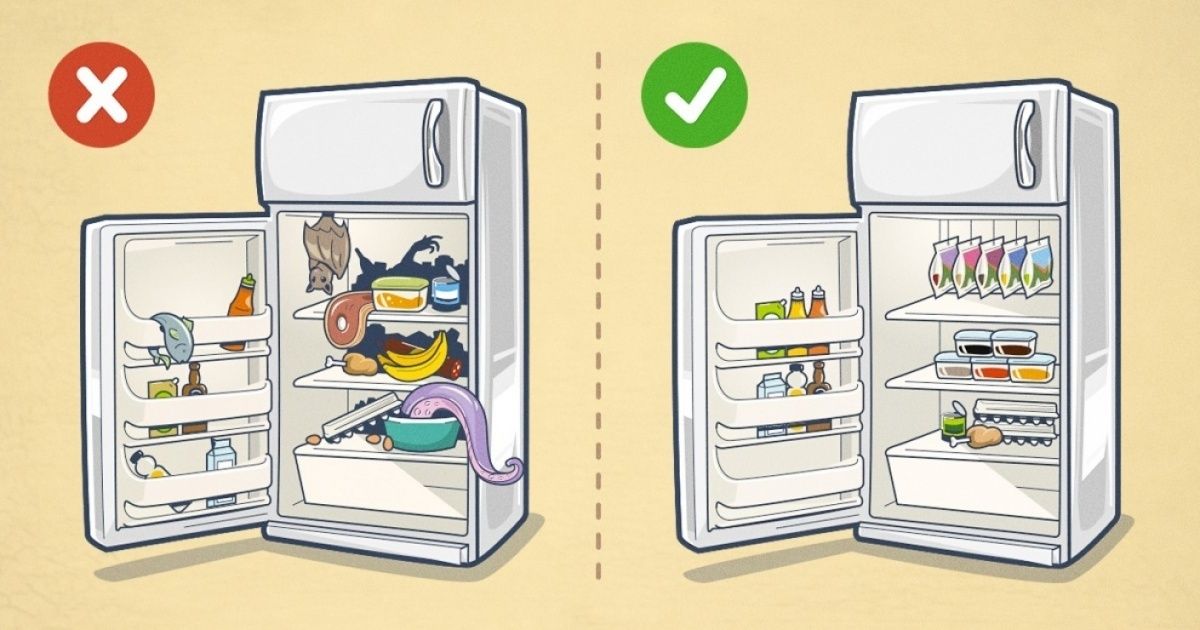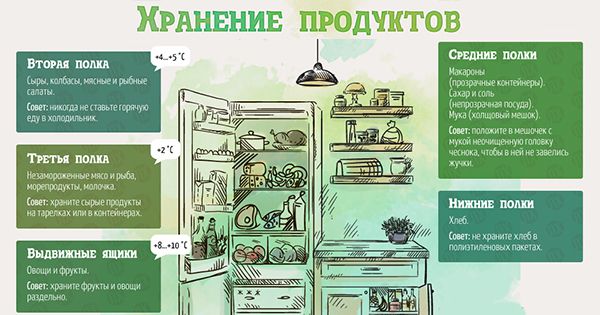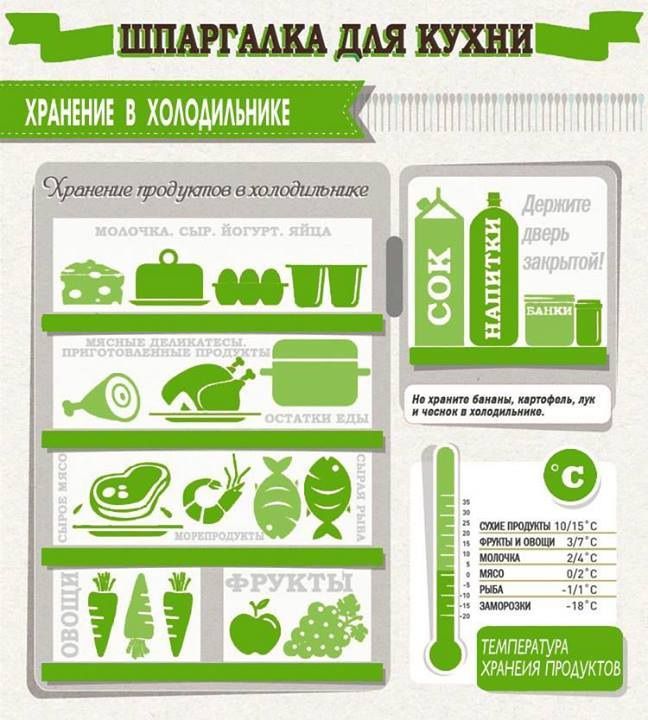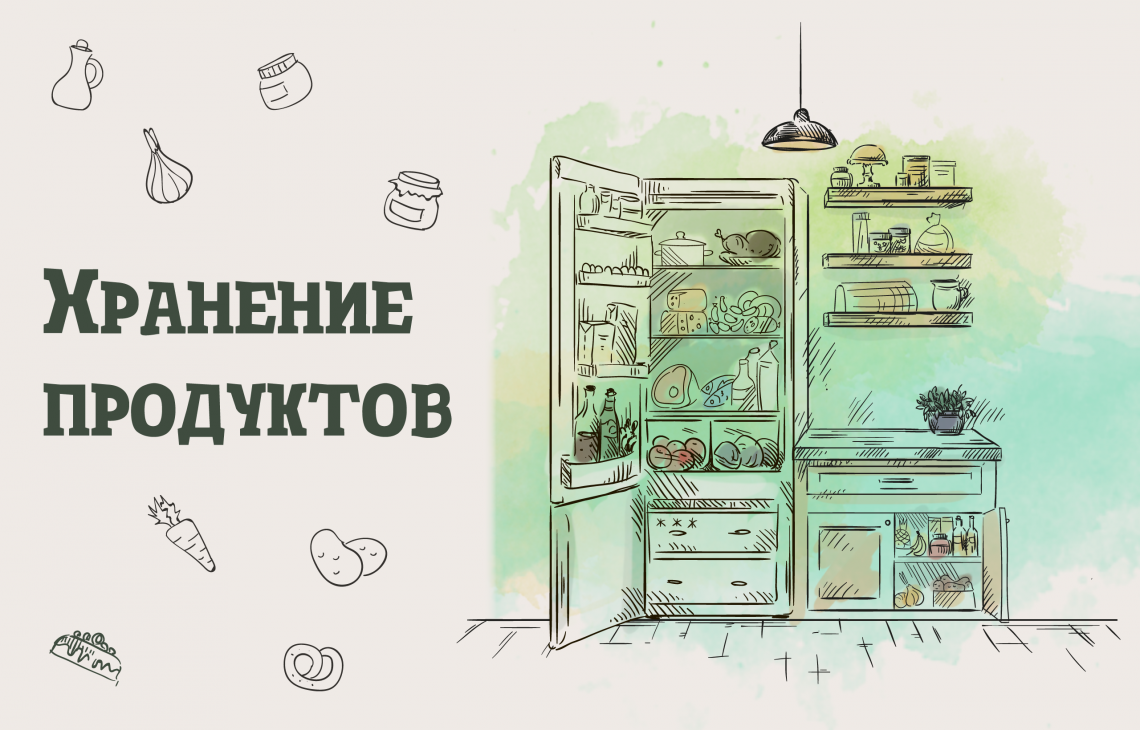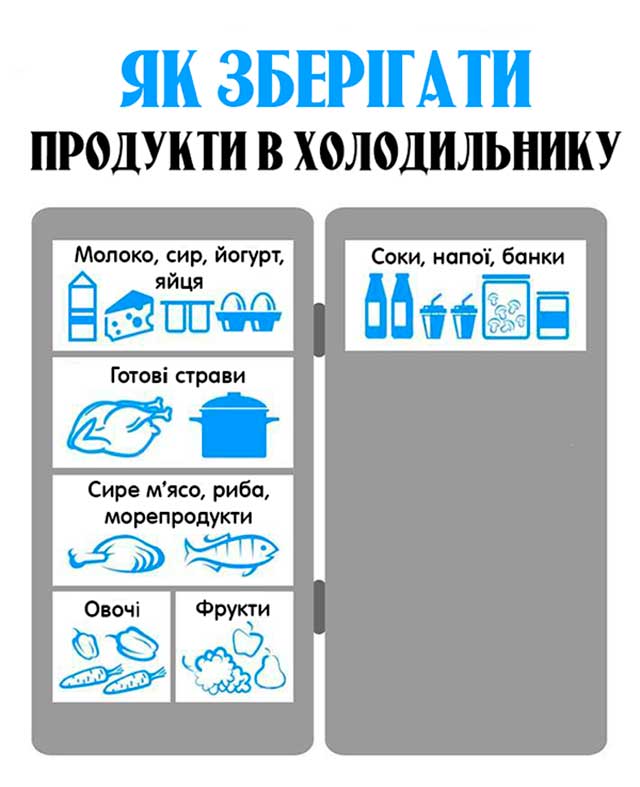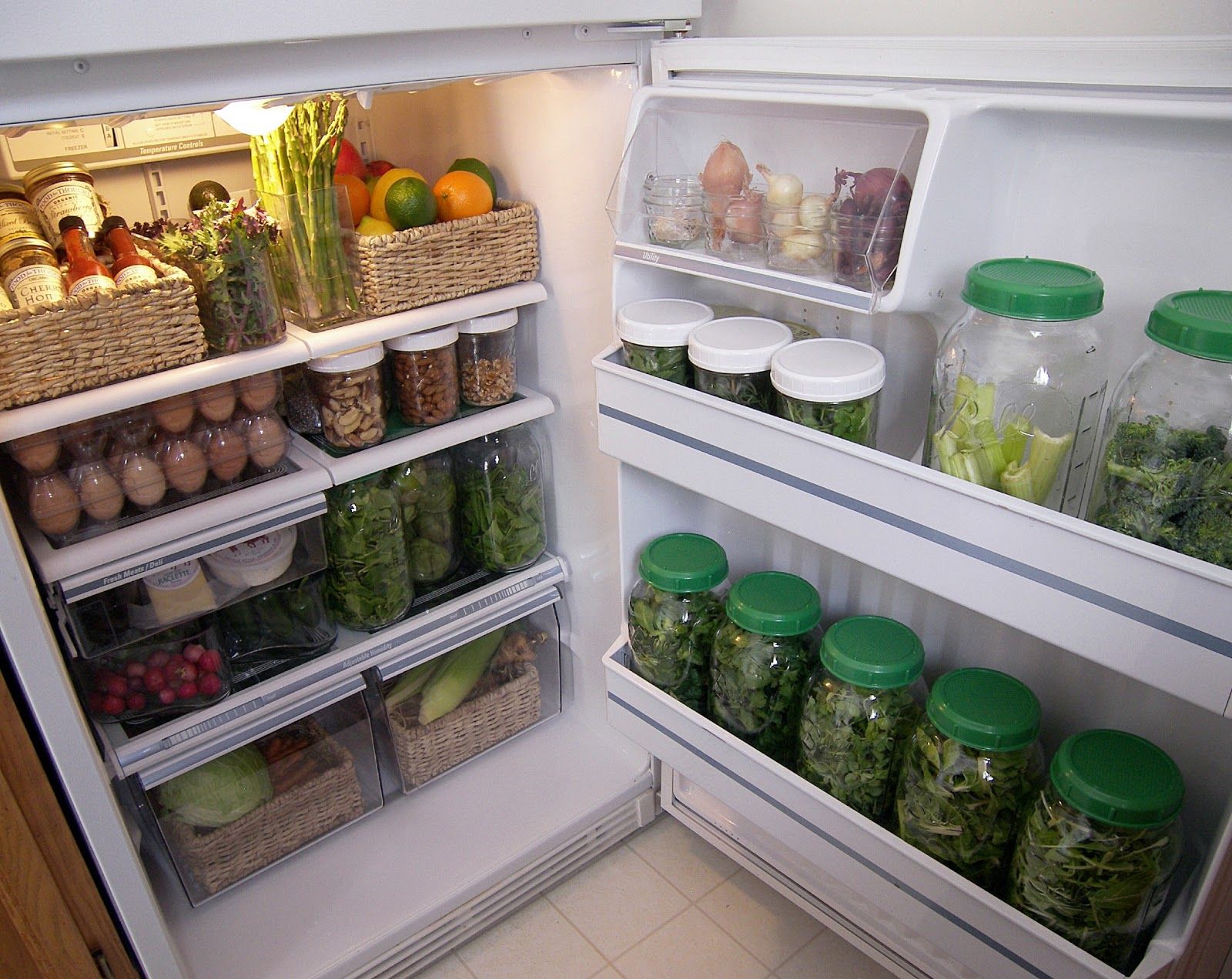Timely my refrigerator
Wipe up stains, accidentally spilled or scattered food and other marks immediately, without waiting for drying. Wipe the handles daily and once a week the door is outside. Then check the shelves and containers for old and unusable food.
Once every three months, completely remove all food from the refrigerator, take out all removable and slide-out shelves, drawers and rinse with warm water and a little detergent. Use a toothbrush and baking soda to scrub away old stains.
At the same time, it is useful to move the empty, clean refrigerator aside, to wash the floor behind and under it. If there is access to the fans and coils of the refrigerator, then vacuum them - because of the dust, they work worse.
Two-chamber refrigeration units
Undoubtedly, the invention of two-compartment refrigerators was a new breakthrough in this niche of kitchen equipment. Having such a unit, you don't have to worry about the food above freezing. Or that food will spoil if you put it on the wrong shelf.
The invention of two-compartment refrigerators greatly improved food storage.
The only caveat is that the door is often opened, a place where you should not put perishable food. It is the warmest here, because the "microclimate" is unstable, however, as in single-chamber models. Opening, they release the delicate temperature balance, so you can put only fresh herbs, eggs, hermetically sealed sauces and drinks here.
The peculiarity of the design of the refrigerator with two chambers
In modern two-chamber models, everything is thought out to the smallest detail. The freezer and the common chamber function separately, each part has its own evaporator, which provides the necessary cold.
A two-compartment refrigerator is a complex system where conditions are created for the best preservation of food.
The coldest place is at the back wall, near the evaporator vents.
Which shelves are the coldest in two-compartment refrigerators
New models with forced convection ensure even circulation of cool streams. All compartments, even an overflowing refrigerator, will have the same temperature. But it should be borne in mind that with such storage, food quickly loses moisture. They should only be stored in sealed containers or tightly sealed containers.
One of the great options for storing food is tight-fitting containers.
If we talk about the freezer, then everything is ambiguous here too. It is warmer on the upper shelf than below, within 10 - 14 ° С below zero. Fruit and berry frozen, mushrooms and seafood are put here.
Fish is stored on the coldest shelf.
The coldest shelf is at the bottom, here is the place for cutting meat, offal, fish and poultry carcasses.
Storing food in the refrigerator: what is allowed and what is not?
Each house has a refrigerator. But not everyone knows how to use it correctly. Few people read the instructions, which explain the purpose of the different areas of the refrigerator. But an even bigger problem is that many believe that it is the cold that creates the optimal conditions for storing food. This is not always the case.
Organization of food storage in the refrigerator
The coldest part of the refrigerator is next to the freezer. This is usually the bottom shelf. Store raw meat, poultry, fish and minced meat there.
- The closer to the back wall, the colder. We often open the door, disturbing the microclimate of the chamber. The contents of the shelves on the doors suffer the most from temperature jumps, but temperature fluctuations are not so noticeable in the depths of the refrigerator.
- The middle shelf is suitable for ready meals as well as eggs.
- Store dairy products, snacks, drinks, sausages on the top shelf.
- Store butter, cheese and sauces on the shelves on the door.
Foods that feel bad in the refrigerator
Many people complain about the lack of space in the refrigerator. But wait: maybe you are trying to store in it something that does not need cold at all and is afraid of high humidity? Here is a list of foods that go bad quickly if left in the refrigerator.
- Most fruits and vegetables. In the refrigerator, potatoes turn yellow, and due to the decomposition of starch, they acquire a sweetish taste. Bananas darken and retain nutrients less well (although their ripening process slows down). The taste of tomatoes deteriorates, they become watery. Unpeeled onions and garlic become softer and milder. Watermelons lose beta-carotene (keep only cut fruit in the refrigerator). Citrus fruits become stained and their skin withers. Eggplants at temperatures below + 10 ° С become loose and lose nutrients. Pears, peaches, apricots, mangoes, kiwi, plums and other juicy fruits become less tasty from the cold. But at the same time, cabbage, radish, radish feel good in the refrigerator.
- Salami. Hard varieties of smoked sausage are nothing more than air-dried meat. The cut point at room temperature may become slightly weathered, but the quality of the product will not change from this.
- Basil. Unlike other herbs (dill, parsley, onions), basil turns black rather quickly in the cold. Better place it in a jar of water and leave it on the table or windowsill.
- Chocolate. Due to the temperature drop, condensation accumulates on the chocolate and the bar turns gray. You can only put it in the refrigerator if you need to return it to its previous shape or if you use it as icing on a cake.
- Bakery products. There is no place for bread in the refrigerator. In the film, it will quickly become moldy, and without it, it will dry out. However, it is allowed to freeze the loaf.
Place slices of bread in the refrigerator if you want to get rid of the unpleasant smell.
- Eggs. Eggs can be stored for up to 20 days without a refrigerator. If you are planning a longer shelf life, it is better to put the tray in the refrigerator. True, in the cold they lose their natural smell and taste. The door is not the best place for eggs. This part of the refrigerator is usually washed less frequently than other shelves, and salmonella can settle there, which can penetrate the porous shell. Store eggs, pointed end down, in store-bought containers away from flavorful foods.
- Vegetable oil. Under the influence of cold, vegetable oils harden, turning into a mass that resembles butter.
- Coffee. Coffee, like a sponge, absorbs odors, which are always abundant in the refrigerator. And this significantly impairs its original taste.
- Honey. It is a natural preservation product. Placing it in the refrigerator will not prolong its freshness. On the contrary, the cold accelerates the crystallization of sugar, and the honey thickens.
- Pickles. Cucumbers, like any other products with marinade or brine, are protected from spoilage by preservatives.
- Ketchup. Even an open bottle of ketchup can be safely left on the table. It will not deteriorate thanks to special additives.
Refrigerator operating rules
In order for the products to retain their freshness and their useful and taste qualities as long as possible, it is also necessary to keep the refrigerator clean.
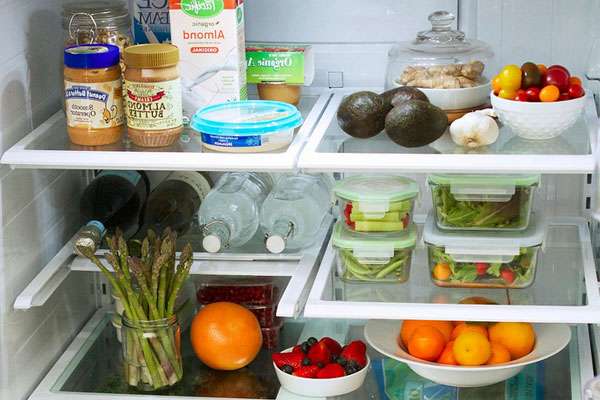
- The shelves and walls of the apparatus should be wiped once a week. However, you cannot use abrasive cleaning agents for this, but rather use special solutions for cleaning the refrigerator.
- Defrost the refrigerator every 3-5 months, regardless of whether it is equipped with the NO FROST function or not.
- An unpleasant smell sooner or later settles in almost every refrigerator, and you can deal with it like this:
- The easiest way is to get a coal absorber of unpleasant odors for the refrigerator - "Anti-smell";
- Water-soda solution, crushed activated carbon and freshly ground coffee are the favorite methods of all housewives in the fight against the refrigeration "aroma";
- Citruses also guard the cleanliness of the refrigerator. Lemon slices, fresh orange peel or a napkin dipped in lemon juice will get rid of persistent smell quickly and for a long time;
- Slices of brown bread, cloves, cinnamon powder, juniper sprig, and basil can also help keep bad odors out of the refrigerator.
Shelf life of food in the refrigerator
A large number of people believe that metabolic processes in products stored in a refrigerator stop, as well as the vital activity of microorganisms. Therefore, the quality of the products will not change after a week of storage and even after a month. It should be said that this is a rather dangerous delusion. In products of plant origin, metabolism occurs during storage in the refrigerator, and enzymatic processes continue in meat and fish. These phenomena not only worsen the original quality of the products, but can also lead them to a state where they become dangerous to human health.
Remember: a refrigerator is not a resuscitation! Therefore, it cannot be assumed that the products stored in it, and especially in a non-frozen state, are not subject to elementary spoilage. The broth turns sour in the refrigerator as well as on the table in the kitchen, but not in 6-7 hours, but in 3-4 days. The effect of enzymes and the development of microorganisms depends primarily on the content and condition of water in the product. The more moisture in the product, the more active the destructive processes are and the shorter its shelf life. Frozen food, in which water is in a solid (crystalline) state, can be stored for a long time.
Safe shelf life of various products:
| Product | Refrigerated storage | Freezer storage |
| Meat dishes | 3-5 days | 2-3 months |
| Bacon, sausage | up to 7 days | 1-2 months |
| Ham, gammon | 4-5 days | 1-2 months |
| Minced meat and semi-finished products from it | 1-2 days | 4-5 months |
| Raw meat | 3-4 days | 4-6 months |
| Bird chunks | 1-2 days | up to 9 months |
| Whole bird | 1-2 days | up to 9 months |
| Boiled poultry in sauce or broth | 1-2 days | up to 6 months |
| Boiled poultry without sauce or broth | 3-4 days | up to 4 months |
| Raw fish | 1-2 days | 2-3 months |
| Fried fish | 2-3 days | 2-3 months |
| Raw eggs | 3-4 weeks | do not freeze |
| Boiled eggs | 5-6 days | 1-2 months |
| Hard cheese | up to 3 weeks | up to 6 months |
| Soft cheese | up to 2 weeks | up to 4 months |
| Cottage cheese | 4-5 days | month |
| Butter | 3-4 weeks | 3-6 months |
| Milk | 5-6 days | month |
| Condensed milk | 4-6 days | do not freeze |
| Ice cream | do not store | 2-3 months |
| Cream cakes | 2 days | do not store |
| Vegetables and fruits | 2-3 weeks | year |
| Berries, fresh herbs | 2-3 days | year |
What shouldn't be kept in the refrigerator?
It is very important to figure out which foods should be in the refrigerator and which should be kept outside. Some foods do not tolerate cold
For example, fresh tomatoes start to mold and become saturated with the smell of the refrigerator, so they are best kept at room temperature. Onions, courgettes, and potatoes keep better in a cool, low-moisture environment, so keep them in a dark cabinet or outside the refrigerator. Avocados and many other fruits ripen faster when left at room temperature. But you can also keep them in the refrigerator if you want to slow down the process. Greens and herbs can be stored both in the refrigerator and outside if you use them for a few days.
There are also foods that need to be refrigerated to keep them as fresh as possible. But if you use them quickly, refrigeration is unnecessary. For example, nuts, peanut flour and butter store well in cabinets.But the refrigerator can prevent the natural oils from separating if you don't use them for a long time. Refrigerate these foods when your kitchen is warm or when you will not be using them for several weeks.
The same goes for whole grain flours (which contain healthy oils and nutrients) and oils that are low in saturated fat, such as canola, safflower, and olive. They will last longer if kept in the refrigerator. But again, if you make almond muffins every week, then you can store this flour at room temperature. If these foods sit in your kitchen for a long time, moving them to the top shelf of the refrigerator or even freezing the flour will prevent the aftertaste that may develop over long periods of storage.
Middle shelves

Here the temperature is within + 3 ... + 6 ° C. This mode is suitable for open canned food, ready-made meals, sausages and slices, sweets. Cooked food can be stored for about 3 days.
On the middle shelves, which are located near the shelves with meat and seafood, they put milk, cottage cheese, sour cream, kefir.
Purchased milk in bags must be poured into a glass jar, but it is still ideal to purchase special holders for soft bags.
Curd is placed in a closed enamel, glass or porcelain dish.
Hard cheeses and butter are placed in an airtight container with several pieces of refined sugar. If there are no containers, they are wrapped in parchment paper or folded in paper bags.
You can also dampen the paper with salt water.
For long-term storage, cheese is placed in Shrovetide together with butter.
Soft cheeses are stored in their own liquid.
The next shelf contains sliced lemon, ginger, watermelon, melon and eggs.
The eggs are folded with the sharp end down, so that they do not touch each other. It is necessary to provide them with air access, but note that they absorb odors.
Before putting the greens in the middle part, spray it with water and do not put it tightly into the trays. A damp cloth is placed at the bottom of the trays.
You can also trim off the ends of parsley, dill, cilantro, basil and place them in a glass of water that is placed in the door.

Product compatibility
When using the refrigerator, keep in mind which foods can be stored side by side and which cannot. For example, vegetables and fruits, oddly enough, are absolutely incompatible in storage, so it is better to keep them in different drawers. If apples and pears are stored together with cucumbers and herbs, then the latter will wilt very quickly and become soft. Tomatoes and bananas are also not very good neighbors for other vegetables and fruits, as they speed up the process of their ripening and, therefore, contribute to the decay of these products.
Smoked meats and fish, which, even in sealed containers, can give off a very pronounced odor, should not be placed next to dairy products, eggs and baked goods. Cooked meals and foods that do not need to be cooked should not be placed next to raw meat or fish. The latter contain bacteria that can cause stomach upset, but these bacteria are killed during cooking. For this reason, such products should not be placed on the same shelf as raw eggs.
The following products are bad neighbors in the refrigerator:
- cheese - vegetables, fruits;
- smoked meats - cheese;
- small sausages, sausages - vegetables, fruits;
- potatoes, cabbage, carrots - fruits;
- bananas are citrus fruits;
- fish - grapes;
- fish - bread;
- fish - salads.
Some foods don't need to be refrigerated at all. For example, jars with different preservation do not need cold at all. Tomatoes, potatoes, onions, garlic, apples, pears, melons, bananas, pineapples, oranges and tangerines feel great at room temperature.Do not clutter the shelves of the refrigerator with products such as nuts, vinegar, vegetable oil, honey, jam, coffee, tea, various cereals and pasta.
There are ten rules, the observance of which helps to better preserve food in the refrigerator:
- raw foods (eggs, meat, fish) and ready meals should not be stored side by side in the refrigerator on the same shelf;
- you can not store nearby products that have a bad effect on each other;
- products are best stored in special containers. This helps to avoid many troubles regarding both the incompatibility of products and the absorption of odors by them;
- vegetables and fruits are best stored unpacked. Such storage prevents the formation of mold and mildew;
- it is recommended to store greens in a "bouquet" put in a jar of water (water must be changed every two to three days);
- eggs should be washed before being hidden in the refrigerator;
- do not forget about the shelf life of products, which are indicated by manufacturers on the packaging. Food should be used on time, even if stored in the refrigerator. Otherwise, they can lose their taste and useful qualities, and often even become life-threatening;
- make it a rule to conduct a complete audit of your refrigerator weekly and use everything that ends the implementation period unscheduled;
- if you have cooked a lot and did not eat, for example, at the holiday table, it is better to freeze all the rest of the food. After a week or two, it will give your family a lot more pleasure compared to when you have to "stuff" holiday salads into yourself for several days in a row;
- always use the freezer for long-term storage. You can freeze not only semi-finished products and fresh vegetables with fruits, but also ready-made meals.
Distribute food on shelves
- The top shelf contains everything you don't need to cook: sausages, sauces, salads, snacks, leftover dishes, as well as canned food from cans that you transferred to another dish.
- Middle shelf - dairy products and eggs. The refrigerator door is not a suitable place for them: it is more often exposed to warm air, and this shortens the shelf life of food.
- Lower shelf - meat and fish.
- Vegetable compartments - naturally fruits and vegetables, just keep them separate from each other. Some fruits (apples, pears, bananas) emit ethylene gas, which can spoil nearby vegetables faster. In the same department, remove leafy greens, after washing and drying them with a paper towel. But herbs (except for basil) are best placed in a jar of water and kept away from the cold back wall.
- Door - juices, dressings and other products with the longest shelf life.
Single-chamber refrigeration units
A characteristic feature of single-chamber models is the location of the freezer. It is located in the upper part of the common chamber, respectively, on the adjacent shelves it is coldest. The evaporator of the negative temperature compartment produces cold.
Single-compartment fridge freezers have the coldest places on the shelf under the freezer.
There are also single-chamber chest freezers used for the transportation and sale of products. For some time, small refrigerators without a freezer were also produced, in which cooling was from the back wall. The temperature there is about the same, but it is not recommended to store food there for a long time.
In refrigerators without a freezer, the coldest places are near the back wall.
The peculiarity of the design of the refrigerator with one chamber
The simplest device has old single-chamber models. They are distinguished by lattice shelves and the proximity of a common space with a freezer. The upper part is always colder, perishable food should be here.
The simplest device is equipped with old single-chamber refrigerators.
However, if we consider different models, the temperature regime in them can differ significantly. This largely depends on the material of the shelves and the overall congestion of the space. Continuous glass and plastic surfaces inhibit the spread of cold.
Which shelves are the coldest in single-compartment refrigerators
The coldest part is at the top, where the cooling source is located. It is better to lay out meat products, fish and semi-finished products here.
In single-compartment refrigerators, the upper shelves are colder.
In the lower part, where it is warmest, there may be vegetables and fruits that spoil from hypothermia. The sign is red spots, pathological microflora often develops in these places.
Review your inventory as often as possible. It is advisable to cook foods with signs of damage as quickly as possible, cutting off the areas with flaws.
What keeps food in the refrigerator
A special chamber with a cool environment, where we all store food these days, appeared relatively recently. However, hundreds of years ago, people noticed that food is stored longer and does not deteriorate in the cold. Before the invention of the refrigerator, it was replaced by a cellar, but now it is difficult to surprise someone even with a separate freezer in the kitchen or vacuum boxes, in which food in the refrigerator can be stored almost indefinitely. Why is it better to keep food in the cold?

Food does not spoil because of the temperature, as some think, but because of bacteria. The fact is that room temperature is an ideal breeding ground for most types of microbes, so if you leave meat in the sun, whole colonies of bacteria will have time to multiply on it in a couple of hours. In the refrigerator, however, a completely different environment, unfavorable for most microbes. Food, of course, spoils in the refrigerator, but much more slowly, since fewer species of bacteria are able to survive in the cold, and those that do do it more slowly.
Roughly speaking, a refrigerator is a tool that allows you to postpone food spoilage for several weeks, and in the freezer - for several months or even a year.
An even more interesting situation with food spoilage in a vacuum environment - now there are special devices on sale that allow you to pump air out of a container with food. In theory, food in a vacuum should not spoil at all, since there are no microbes in an airless environment. In reality, of course, everything is not so, because it is possible to pump out 100% of air only in a laboratory, but this will not be enough either. Some bacteria will still remain in the food itself, in its structure, on the surface. However, in such an almost airless environment, you can extend the shelf life of food even more, especially if you place them in a freezer - meat in a vacuum at low temperatures will be stored for up to 2 years.
So that you are not completely confused, we suggest you schematically familiarize yourself with the scale of the shelf life of food:
- Warm, humid environments are the worst place to store food, meat spoils in a matter of hours, depending on the temperature.
- Room temperature - little food is stored in it, meat can go bad in one day, but fruits will remain fresh from several days to several weeks, depending on the type.
- Refrigerator, at a temperature of +5, the shelf life of food increases significantly, fresh meat will lie for up to a week, some types of meat products more than a week, depending on the processing.
- Freezer - chicken up to 1 year, fish up to 6 months, minced meat up to 2 months.
- Vacuum box in the freezer - about 2 times longer than just in the freezer.
Keep in the refrigerator only that which does not tolerate room temperature.
Don't put everything in there. Most fruits and some vegetables - such as tomatoes, cucumbers, courgettes, and onions - can be stored in a warm, dark place.
Do not leave food in a tin can after you have opened it: upon contact with air, the tin begins to oxidize, resulting in the formation of harmful substances that enter the contents.It is better to transfer the canned food to another container, and discard the can. Only cans that come with closable lids can be stored in the refrigerator.
Also no place for bread in the fridge... And most importantly: do not put hot food there - this will quickly damage the device.
It is imperative to store ripe and overripe fruits and berries, dairy products, eggs, any fresh and ready-to-eat foods in the refrigerator. Opened wine - even red wine - should go into the refrigerator. But open pickles, jam, mustard can be stored in a cool dark cabinet, unless the instructions say otherwise.
Consequences of non-compliance with sanitary standards
Failure to comply with statutory sanitary norms and rules can worsen the quality of food products, shorten shelf life and storage, and make food dangerous for consumption.
What are the reasons for this to happen? Raw meat or minced meatballs can infect nearby borsch or stew with pathogenic bacteria. Thermally unprocessed foods are a source of pathogenic microflora, therefore, the rules assume separate storage of foods with varying degrees of readiness.
Even if the product has not become hazardous as a result of storage, the quality can be significantly affected.
A product with altered organoleptic properties is less valuable and useful for the body. If you bought dry biscuits and spiced herring in a store, then even bringing such incompatible products home is worth it separately, otherwise you won't be able to rid the biscuits of the persistent aroma of marinade and spices later.
Fruits and vegetables should be sorted periodically, getting rid of rotting and overripe specimens. If this is not done, the entire volume of production will soon deteriorate.
12 prohibited foods
We persistently stuff everything indiscriminately onto the "Arctic" shelves, but not all food components tolerate the "cold snap" well, there are some among them that cannot be stored in the refrigerator at all.
- Exotic or tropical fruits begin to rot when exposed to low temperatures.
- Apples and pears from domestic producers at low temperatures strive to isolate ethylene, which destroys both themselves and all other products that are in their close environment. Therefore, the pressing question, where is the best place to store apples, implies the answer: say no to the refrigerator.
- Zucchini, pumpkins and melons rot and mold from the cold.
- Tomatoes, cucumbers and eggplants, being moisture-containing vegetables, rapidly darken and subsequently rot from low temperatures.
- In the cold, olive oil curls up, thickens, loses its valuable qualities and begins to taste bitter.
- And low temperatures have a depressing effect on potatoes. In addition to the fact that the cold turns starch into sugar, besides, with all this, the tubers begin to rot.
- Turnip onions, once in the refrigerator, become soft and lethargic.
- In honey, all useful biochemical substances are destroyed in the cold.
- When storing chocolate in a refrigerator, the latter forms a whitish coating on the surface, which over time can play an evil moldy joke with your favorite delicacy.
- Bananas lying on the shelf of the refrigerator turn black and not appetizing.
- Garlic is thermophilic and threatens to rot when stored cold.
- There is certainly no place for bread in a refrigerator. In addition to the fact that the refrigerator will draw all the "juices" out of it, it will also reward you with all possible aromas.
Shop sausages
Now let's move on to the storage features of each individual species. Let's start with purchased items. Although the manufacturer indicates the storage conditions for each, you still need to know the main points.
Smoked and dry-cured varieties
Most often, boiled-smoked or semi-smoked varieties are bought from smoked varieties. Such sausages should be stored only in the refrigerator at a temperature of + 4-6 degrees.If the casing is intact, the shelf life is from 2 weeks to 1 month. When frozen, the period is extended to 3 months.
Raw smoked sausages are stored much longer - up to 4 months unopened on a refrigerator shelf and up to 9 months in a freezer. It is better to use an already started stick within 3 weeks. Such sausage can be kept not only in the refrigerator - if there is a ventilated room with a constant temperature not higher than 16 degrees, then a high-quality uncooked smoked sausage will remain fresh for about 2 months.
Dry-cured sausage is a real delicacy that is made by drying from natural meat. Usually it is beef or pork, but you can also find horse, lamb, etc. on the shelves. It is this type of sausage that has the longest shelf life, which makes it indispensable for a hike, for example. It will stay fresh in the refrigerator for 6 months. And even at room temperature, unopened dry-cured can be stored for about a month.
Storing cooked sausages and ham
Cooked sausage, ham, wieners and sausages are not stored for long. The shelf life can vary from 2-3 days to 6 weeks, depending on the variety, filling, type of casing and manufacturing technology. Keep such products only in the refrigerator.
You can freeze boiled sausages, but it is advisable to heat them before eating. Better yet, make something interesting like German sausage soup or pizza
Top of the refrigerator
If you're using this space as a food loft to stack bottles or loaves of bread, stop. Even if your kitchen is very small and this seems like a convenient solution, it's not a very smart idea. To regulate the temperature inside, the condenser coil of the refrigerator blows warm air, and this heat rises to the combi steamer. As a result, this space heats up quickly. And heat is unacceptable when storing wine. And in such conditions, bread molds faster. What is the best way to use this space? You can put paper towels or cookbooks in there.
Pitt and Aniston together again? Fans noticed a ring on the actress's finger
How to make fun fruit and coconut sushi cupcakes: a recipe
The singer Sia admitted that she became the mother of two adopted children


